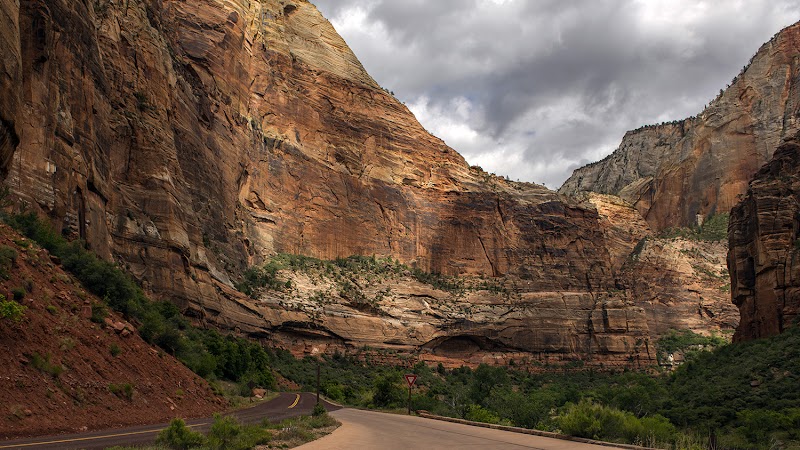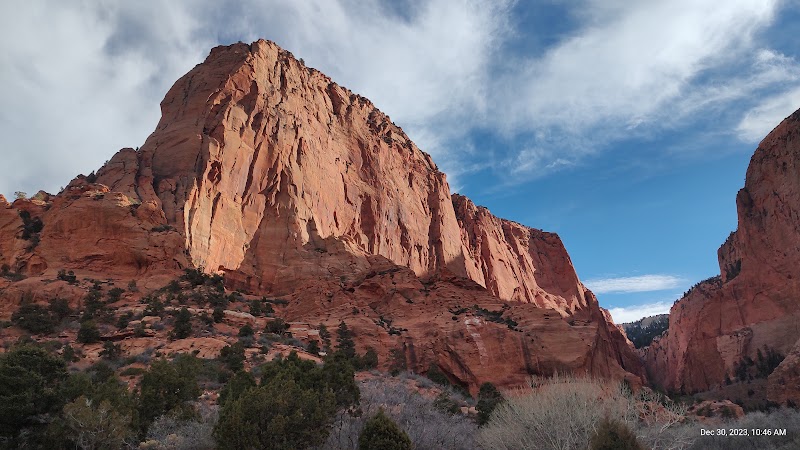Welcome to Zion National Park
Welcoming over 4.5 million visitors annually, Zion National Park is a paradise of towering cliffs, deep canyons, and awe-inspiring landscapes embracing 229 square miles. With jaw-dropping attractions such as Angel's Landing, the labyrinthine Narrows, and the serene Emerald Pools, this unique destination beckons you to immerse yourself in its natural splendor and witness the timeless beauty of America's wilderness. And, to navigate this vast wilderness, arm yourself with the “Tourist Map of Zion National Park”.
As you embark on your adventure, a comprehensive tourist map will be your trusted guide. It won't just chart your journey across Zion's vast wilderness, but will also unravel the secrets of this magnificent landscape. With the map as your guide, you're all set to explore the wonders of Zion National Park and create memories that will last a lifetime.
" Booking.comExploring the Enchantment of Zion National Park
Zion National Park is much more than its towering cliffs and breathtaking landscapes. From uncovering hidden waterfalls to exploring ancient rock formations, Zion offers a myriad of unique and unforgettable experiences. Let's delve deeper into the heart of this American gem to discover what makes it so special. And if you are also planning to visit other national parks, make sure to check out the tourist map of Canyonlands National Park, another wonder of nature.
The Top Experiences in Zion National Park
- Canyon Overlook Trail
- Kolob Arch
- Riverside Walk
- Observation Point
- Checkerboard Mesa
- Weeping Rock
Canyon Overlook Trail: A Panoramic View of Zion
Among the most rewarding hikes in Zion is the Canyon Overlook Trail. At the peak, you're greeted with a panoramic view of Zion Canyon, a sight as humbling as it is breathtaking. This trail's accessibility makes it a perfect pick for families and novice hikers. And from this vantage point, you can see the hidden gem, Pine Creek Waterfall, which often goes unnoticed.
Kolob Arch: A Monument of Nature's Artistry
As one of the world's largest freestanding natural arches, the Kolob Arch is a testament to nature's artistry. The grandeur of this arch is only superseded by the tranquility of the surrounding wilderness, painting a picturesque scenery that's hard to forget. This arch nestles within the Kolob Canyons area of the park, an area boasting some of the most unspoiled landscapes in Zion National Park. And speaking of natural wonders, you might also want to explore the splendors of the Arches National Park.
Riverside Walk: A Gentle Stroll Along the Virgin River
For a more relaxed experience, the Riverside Walk offers a gentle ramble along the Virgin River. With lush vegetation, diverse wildlife, and the soothing sound of the flowing river, this walk is a sensory delight. As you saunter along the pathway, you'll notice it leads to The Narrows entrance, making it an excellent precursor to one of Zion's most iconic hikes.
Observation Point: The Highest Viewpoint in Zion
Observation Point isn't just a hike; it's an experience. As Zion's highest viewpoint, it offers a bird's eye view of Zion Canyon, Angel's Landing, and the White Throne. Though the hike is quite challenging, the reward is worth every effort. Remember to check your tourist map of United States to locate this unforgettable trailhead.
Checkerboard Mesa: A Geologic Wonderland
Checkerboard Mesa is a geologic marvel as fascinating as it is winsome. Its checkerboard pattern is a natural phenomenon formed by wind-blown sand's crossbedding and the weathering of the Navajo Sandstone. This unique rock formation stands as a testament to nature's power and artistry.
Weeping Rock: A Natural Oasis
True to its name, Weeping Rock is a large rock alcove that seeps water, creating a beautiful 'weeping' waters spectacle. This natural oasis houses hanging gardens and a diverse range of plant species, earning it the title 'the park's greenhouse'. It's a perfect spot to pause and immerse in the serene beauty of Zion National Park.
Whether you're an adventure enthusiast or a nature lover, Zion National Park offers something for everyone. Its diverse landscapes, rich history, and unique experiences make it an unmissable destination in the American wilderness. With every step, Zion invites you to delve deeper into its heart, discover its secrets, and create memories that'll last a lifetime. And if you have some more time, do not miss the chance to visit the Grand Canyon, a natural wonder that's just a drive away.

Practical Information for Zion National Park
Navigating through Zion National Park requires careful planning and understanding of the park's unique conditions and systems. Here's a practical guide providing you with the necessary details for a smooth and enjoyable visit.
Transportation and Mobility
Private vehicles can only access the park during the offseason, from November to mid-March. From mid-March till late November, the only way to access the Scenic Drive is through the park's free shuttle service. Park and Ride lots are available in Springdale and at the park's entrance.
For those staying outside the park, the Springdale Shuttle connects with the Zion Canyon Shuttle at the park's entrance. It operates daily and stops at nine locations in town. Cycling is also permitted on all park roadways and on the Pa'rus Trail.
Schedules and Prices
Zion National Park is open 24/7 year-round, but individual attractions may have varying schedules. The Zion Canyon Visitor Center operates from 8 am to 5 pm, while the Kolob Canyons Visitor Center operates from 8 am to 4:30 pm.
The entrance fee to Zion National Park is $35 per vehicle, valid for seven days. An individual entry ticket costs $20, while a motorcycle entry ticket is $30. The yearly Zion Pass is available for $70, providing unlimited access to the park. Fees can be paid at the Zion Canyon or Kolob Canyons entrance stations.
Safety Tips
Staying safe in Zion National Park means respecting nature's power and adhering to the park's rules and guidelines. Always stay on established trails and avoid cliff edges. Flash floods pose a real threat in Zion, so always check the weather forecast and heed all warnings and closures.
Remember, wildlife is to be observed from a distance—do not feed or approach animals. Bring plenty of water, wear sun protection, and be prepared for changing weather conditions.
Practical Recommendations
Visiting Zion National Park in spring or fall offers moderate temperatures and fewer crowds. However, always be prepared for varying weather conditions since temperatures can fluctuate dramatically within a single day.
For the best experience in Zion, plan your visit on weekdays and arrive early in the morning. This is when you'll encounter fewer crowds and have a better chance of finding parking. Also, ensure to book your accommodation well in advance, especially during peak season.

Frequently Asked Questions about Zion National Park
Q1: Are there any unique wildlife species in Zion National Park that I should look out for?
Absolutely! Zion National Park is a sanctuary for a vast range of wildlife. You might spot mule deer, wild turkeys, and numerous species of birds. The elusive mountain lion also roams these lands, but sightings are rare. Remember to enjoy these creatures from a distance and avoid disturbing their natural behavior.
Q2: What are the wheelchair accessibility options in the park?
While Zion National Park's rugged terrain may pose challenges, there are still opportunities for wheelchair users to experience its beauty. The Zion Shuttle has spaces for wheelchairs, and two of the park's most popular trails, Riverside Walk and Pa'rus Trail, are wheelchair accessible with some assistance.
Q3: Are there any specific rules or regulations I should be aware of?
Yes, it's crucial to remember that Zion National Park is a protected natural area. So, collecting or disturbing wildlife, plants, rocks, or historical artifacts is illegal. Campfires are only permitted within fire rings at designated campsites. Finally, pets are not allowed on most trails, except the Pa'rus Trail.
Q4: I'm an avid photographer. Are there any restrictions on photography within the park?
Photography is highly encouraged as a way to preserve your memories of Zion National Park. However, commercial photography requires a permit and drone photography is prohibited. Remember to respect the park's natural beauty and avoid stepping off trails for that perfect shot.
Q5: Are there any recommended times to visit to avoid the crowds?
Visiting in the shoulder seasons of early spring and late fall can help you avoid the biggest crowds. Weekdays, particularly Tuesday through Thursday, also tend to be less crowded than weekends. Regardless of when you visit, try to arrive early in the day for the best parking and shuttle availability.
Q6: What should I know about the weather and how to prepare for it?
The weather in Zion National Park can be extreme and unpredictable. Summers are hot, winters can be cold, and flash floods are a risk during the monsoon season (July - September). Always check the forecast before your visit, bring plenty of water, and dress in layers to adapt to changing conditions.

